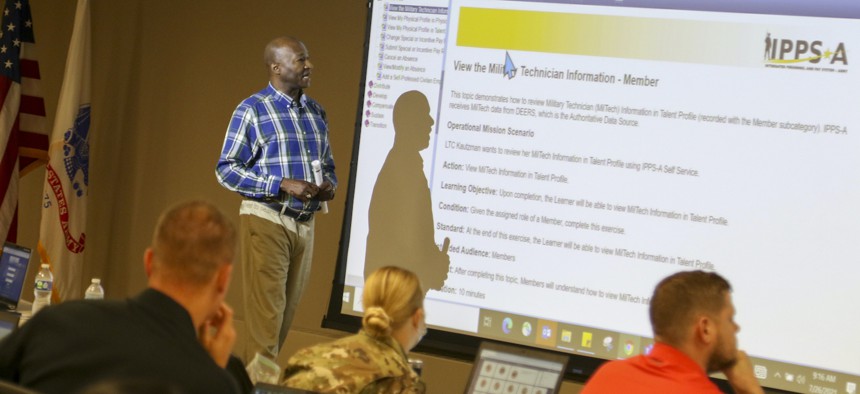
An IPPS-A train the trainer event at Fort Snelling, Minn., July 26, 2021. U.S. Army / Zachary Mott
Army Debuts Improved Smartphone-Friendly Pay System
Starting Jan. 17, more than 1 million soldiers will be able to try out the new, more automated HR system.
After a year of delays, the Army’s updated human resources system promises all 1.1 million soldiers the ability to access crucial forms, like those needed to list beneficiaries in an emergency or death, while also allowing them to showcase talents and skills outside their assigned specialties—all from their phones.
“Release 3 improves upon our ability to manage soldier talent, reduce pay discrepancies, and allow our soldiers to track their personnel actions from the initial activity all the way through the approval process, whether using their computers or from the convenience of their smartphones,” Lt. Gen. Douglas Stitt, the Army’s deputy chief of staff for G-1, told reporters ahead of the debut.
The Integrated Personnel and Pay System-Army, or IPPS-A, has been in development and tweaked with phased releases for years. This latest upgrade, Release 3, was originally planned to roll out across the Army—including reserve and guard components—in December 2021.
The extra time for the updates was necessary for troubleshooting, according to Col. Rebecca Eggers, the Army’s functional management division chief, who oversees IPPS-A’s requirements, business processes, deployment, and training strategy.
“We tested the system enough that we know that it's stable and that the functionality works as intended. So last year, when we went through our initial test phases, the system definitely wasn't ready…so we took a pause and really looked at what we would need in order to deliver the system in its entirety,” Eggers said.
The Army began rolling out the system late last year, which involved sunsetting legacy systems and manual processes, and making sure all the data aligned.
The new system is the culmination and melding of multiple systems and their data into one. It’s working well so far, but resolving data discrepancies is the primary focus and concern, Eggers said. They were still monitoring data for personnel actions that occurred during the latest period of restricted use leading up to the release, but that work was expected to be completed by the time the system went live.
The system is part of an Army-wide effort to emphasize data collection and analysis to improve missions and daily tasks, like filling out forms.
“HR modernization is long overdue,” said Sgt. Maj. Gary Krese, senior enlisted advisor for the functional management division.
IPPS-A’s latest iteration allows “soldiers to take care of their own records, to ultimately take care of their families, and really just manage every aspect of their career, especially when it comes to personnel actions.”
For example, the new system will automatically trigger pay transactions when a personnel action is made to eliminate pay delays or errors that could arise when soldiers are deployed or return home.
The goal is to streamline “the process for transferring between deployments, between assignments, and even between components. This allows soldiers to easily execute mobilization and demobilization actions with HR professionals to decrease delays and pay transactions, decrease errors in information, and even decrease loss of data,” Krese said.
There’s also a soldier talent profile feature that allows soldiers to snapshot their unique knowledge, skills, and behaviors to “show the Army other things that they can do outside of their primary MOS,” a function that could make them more attractive for nominated assignments and promotion, Krese said.
That data could help leaders identify the talent that exists or may be missing from their formations, particularly for reserve components, where soldiers may have a day job or career that significantly differs from their assigned job.
That means HR can “look across all three components and see, OK, who in my formation has these knowledge, skills, and behaviors? That information is queryable. And we're not limited anymore,” Stitt said. “Self-professed talents, now, are at our fingertips.”
And because the Army’s human resources professionals now have more data to sift through, the skills they need to master are shifting.
“IPPS-A changes how we do business,” Eggers said. “You're able to analyze that data and someone needs to do it. So our skill sets [have] changed a bit.”
That means HR professionals will have to be more “proactive” with data, since they don’t have to hunt for it, Stitt said.
“We can better anticipate a commander’s decision,” he said. “How many people do we have in the formation? Well, we can answer that on the spot. But also, let's get into the details of, you know, who makes up that…what skills do they have?”




